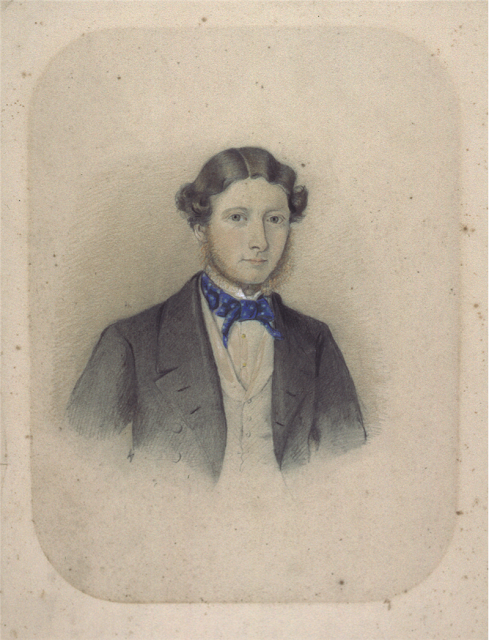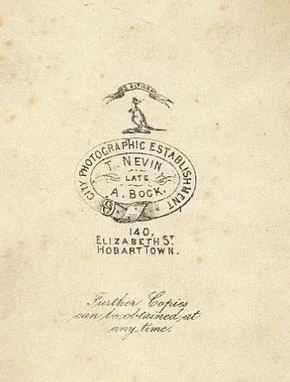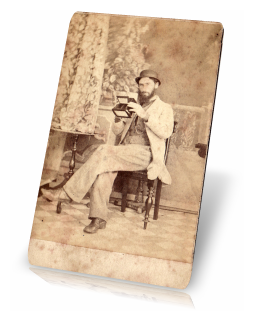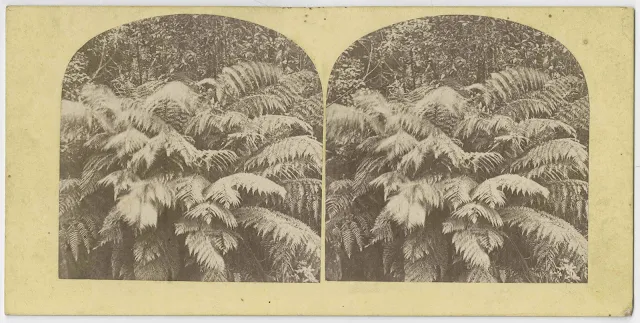Photographer Thomas J. Nevin's facial hair fashions
There are not many extant "self portraits" of Tasmanian colonial photographers of the 1850s-1880. The watercolour attributed to Alfred Bock of a young gentleman is held at the State Library of Tasmania; the stereograph of a supine Thomas J. Nevin and friend is held at the Tasmanian Museum and Art Gallery; and the rest are held in descendants' private collections. These portraits all exhibit interesting variations in male facial hair fashions.
1850s:
Watercolour of Thomas J. Nevin as a fresh-faced teenager:

[Portrait of a young gentleman]
Attributed to Alfred Bock.
Unsigned and undated.
1 drawing : pencil, pastel & watercolour on paper ; 25 x 19 cm within matt.
Source: https://stors.tas.gov.au/AUTAS001127111433w800
Allport Library and Museum of Fine Arts
This watercolour, unsigned though attributed to Alfred Bock, is included in the selection because it may well represent the young Thomas J. Nevin while apprenticed to Alfred Bock in the early 1860s. If dated to ca. 1859, it shows a 17 year- old youth's wispy set of mutton chops, a clean shaven chin, no moustache, and wavy hair parted slightly off-centre. These are the same facial fashions which characterised Thomas J. Nevin's style in his wedding photograph, aged 28 yrs, in 1871.
The violet bowtie with white spots in this painted portrait, which is expertly executed, is similar to the hand-tinting of neck wear in several photographic portraits of private clients and prisoners by taken by Thomas Nevin in the 1870s. See also this entry on the red and violet in Brewster's stereoscopy.
1860s:
This photographic portrait of Thomas J. Nevin, 23 years old, taken at an early stage of his career as a young stereographer, is pictured here wearing white gloves and holding a small stereoscopic viewer. The studio decor suggests it was taken in Alfred Bock's studio ca. 1865-8.

Thomas J. Nevin, seated, facing camera, holding a stereoscopic viewer in white gloves
Carte-de-visite on buff mount. Verso is blank.
Copyright © KLW NFC Imprint 2009 Private Collection
The studio decor differs in every respect from Thomas Nevin's portraits of his parents and private clientele taken at his studio, formerly Alfred Bock's, the City Photographic Establishment in the 1870s. The drape is intensely floral with large motifs; the table has a single support and a beaded bevelled edge (it's not his table with the griffin-shaped legs); the carpet features a plain diamond pattern; his upright chair is from a dining set and behind his chair is a three-footed (head)-stand; and the painted backdrop is awash with a flowering bush and sketchy version of a balustrade. It is not the Italianate balcony with disappearing river vista of his later commercial portraits of private clientele. This suggests it was taken at Alfred Bock's studio ca. 1867 before Bock's departure to Victoria. By 1864, and prior to Bock's departure, Thomas Nevin had established a studio at New Town near his parents' family farm at Kangaroo Valley and advertised his stereographs for sale at the nearby New Town Post Office. He maintained the New Town studio concurrently until 1888.
Thomas J. Nevin's facial features are very clear. The mutton chops have thickened, he's grown a moustache and a beard possibly because this capture was taken during winter. He appears to be wearing a double layer of clothing underneath the belted waistcoat. At this close range, another facial feature becomes evident. His eyes do not align. One is turned, or one is not. He may have been in an accident, perhaps involving photochemicals, or developed a problem from excessive viewing of stereographs (which required crossing the eyes). Or it may be an effect from pinpricking of the eyes after printing, a common technique in early portraiture for light, or simply an effect of refraction from the camera lens as it caught his pose.
This stereograph (below) of a supine Thomas Nevin and friend on the Queen's Domain, Hobart was probably taken ca. 1868. By 1870, Thomas Nevin was producing commercial stereographs in large numbers, often travelling in the company of colleague and prolific stereographer Samuel Clifford.

The small bowler hat and patterned waistcoat are unmistakeable, so is the beard. Is this a supine "selfie" or was Thomas J. Nevin and his friend photographed with his own camera at the Queen's Domain (Hobart) by his brother Jack Nevin?


Stereograph by Thomas J. Nevin, ca. 1868-70
Self portrait (in hat) and male friend reclining on the Queen's Domain, Government House in distance.
Verso blank, inscription "Domain Hobart per G. T. Stilwell, Librarian, SLT."
Photos recto and verso copyright © KLW NFC Imprint 2014-2015
Taken at the Tasmanian Museum and Art Gallery, 10 November 2014
TMAG Ref: Q16826.3

Full-length standing portrait of Thomas J. Nevin with hat and table-top box stereoscopic viewer
Copyright © KLW NFC Imprint & Shelverton family private collection 2007 -2009 ARR
Thomas J. Nevin's impressive equipment is on show here. This full-length portrait was taken in his studio at the City Photographic Establishment, 140 Elizabeth St. Hobart Town, probably by his younger brother Jack (John) Nevin. Visible in this portrait is the familiar table with the griffin-shaped legs. On the table is a large box stereoscopic viewer with the stereograph holder open.
The variations of facial hair continue, this time Thomas has grown a denser set of mutton chops, shaved off the beard and kept the moustache. By 1868 he was contracted to the Lands and Survey Dept. His contractual agreement, which lasted 14 years, continued with the Office of Inspector of Police within the Municipal Police Office at the Hobart Town Hall when he was appointed Hall and Office keeper in 1876. This image was scanned from a copy pasted into his son George Nevin's scrapbook. .
"Self-portrait" shutters were not introduced until the early 1900s so this photograph, or indeed many taken in the 1860s-70s, cannot strictly be termed a "selfie". The supine pose in these outdoor photographs of the period, of men in particular, was due partly to the size, the focal length, width and aperture of stereo lens types available and partly because a standing rather than reclining figure in the foreground deflects the eye from a distant focal point, which in this example (above) of a supine Nevin was one carrying a salient message about Empire and Colonial stability, the new Government House (completed 1857). The invisible photographer was present in at least five extant photographs of Thomas J. Nevin in various poses and formats, held in family collections, and there may be several more in public collections waiting to be identified, such as this one first viewed at the Tasmanian Museum and Art Gallery, November 2014.
1871:
The full-length portrait of Thomas James Nevin with Elizabeth Rachel Day taken on July 12, 1871, has survived doodling and photochemical damage in descendants' collections. Now a married man and professional photographer, he managed two studios, one near the Nevin family farm at Kangaroo Valley, New Town, and one in the city at 140 Elizabeth St., Hobart:

Thomas Nevin and Elizabeth Rachel Day, July 12, 1871.
Wedding photograph, full-length carte-de-visite. Verso is blank.
Copyright © KLW NFC 2005-2009 ARR.
Thomas James Nevin married Elizabeth Rachel Day on July 12, 1871, at the Wesleyan Chapel, Kangaroo Valley, Hobart Tasmania, in his finest suit and top hat. This photograph shows his mutton chops are wispy again, suggesting he periodically shaved them off. He has kept the moustache, but reverted to the clean-shaven chin, and brushed the wavy hair straight back. The couple was photographed in his studio, The City Photographic Establishment, 140 Elizabeth Street, Hobart Town, possibly by his younger brother Jack Nevin (1852-1891). The verso is blank.

Thomas Nevin wedding group portrait 1871
Unmounted paper print
Copyright © KLW NFC Imprint Private Collection 2009
A clean-shaven chin, mutton chops and moustache were favoured by all the adults males in this group portrait of Elizabeth Rachel Day and Thomas J. Nevin, also taken at their wedding in 1871. The clean-shaven young man at extreme right, was Jack Nevin (by 1875, known as Constable John Nevin), Thomas' younger, barely 19 yrs old. This unmounted print was for private family viewing, and has survived, albeit badly damaged, in descendants' collections.
1873-1876:
This formal portrait printed in an oval buff mount was Thomas J. Nevin's business card. Now a young father and government contractor, this cdv accompanied his renewal of government contracts, and commercial circulars advertising his services and prices to private clients and patrons.

Photographer T. J. Nevin ca. 1873
Self-portrait in oval buff mount
Copyright © KLW NFC Imprint Private Collection 2005
This self-portrait of Thomas J. Nevin was printed and mounted as a standard commercial carte-de-visite. The same format was used by professional photographers commissioned to work for police and prisons in Victoria, South Australia and NSW from the late 1860s (eg. Frazer Crawford and Charles Nettleton). Thomas Nevin used the same oval mount format from 1872 to the 1880s for printing the final identification photos of Tasmanian prisoners to be pasted to the prisoner's record or rap sheet, a format which persisted into the 1890s at the Hobart Mayor's Court and Municipal Police Office when the prisoner was photographed on arraignment and discharge. Thomas J. Nevin was the government contractor for this work from 1872 at the Port Arthur prison, Tasman Peninsula and Hobart Gaol, Campbell Street, Hobart. His other contractual work with the Lands and Survey Department and the Hobart City Council was photographing damage from floods, mining operations, HCC personnel, and the Royal Mail coach operated by Samuel Page whose service included the carriage of prisoners into custody at the Hobart Gaol.
This portrait of Thomas J. Nevin was lightly tinted with rose on the cheeks. The mutton chops are gone, and the beard (which was red) is longer. The off-centre part and wavy hair recall the style of the early watercolour image ca 1859.

The verso carries the "T. Nevin late A. Bock" stamp with kangaroo design.
RELATED POSTS main weblog
- Key chronological events in Thomas J. Nevin's life 1842-1923
- The Nevin group portrait and wedding photo 1871
- Thomas and Elizabeth Nevin's Wedding Photographs 1871

Thomas J. Nevin, seated, facing camera, holding a stereoscopic viewer in white gloves
Carte-de-visite on buff mount. Verso is blank.
Copyright © KLW NFC Imprint 2009 Private Collection





